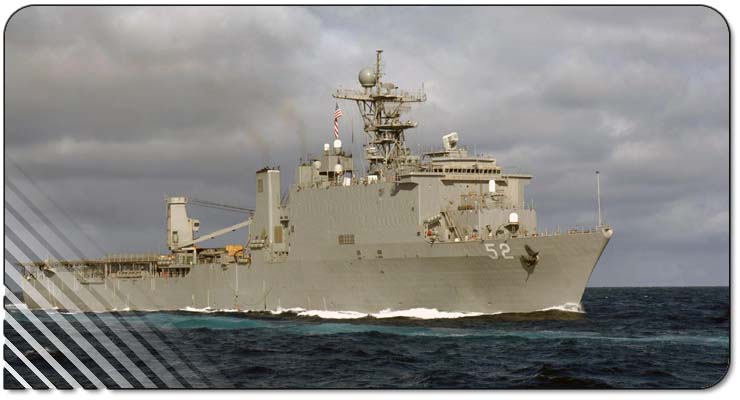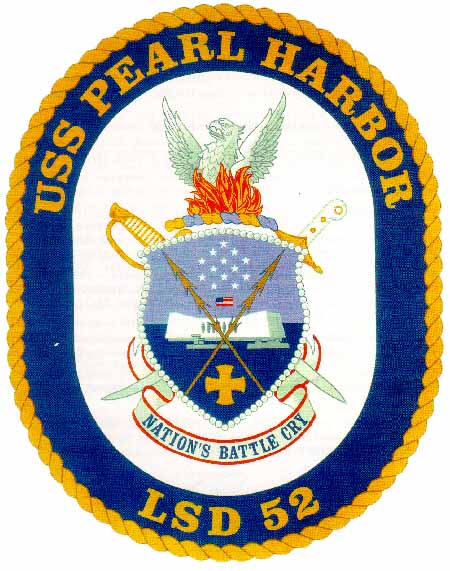Namesake:
Pearl Harbor, HI
The attack on Pearl Harbor, Hawaii, was the famous surprise attack
which caused the entrance of the United States into World War II. The
attack was planned by Fleet Admiral Isoroku Yamamoto, who based it off
several other successful surprise Naval attacks, including one by US
Admiral Harry Yarnell. The actual scale and attack plans were
officially planned by Commander Minoru Genda.
The main purpose of the plan was to take away or significantly cripple
the American forces in the Pacific, allowing Japan access to much
needed resources in Southeast Asia and the Dutch East Indies. They
believed a successful attack on the isolated islands would cause the
U.S Pacific Fleet to retreat to the bases in California. This would
allow the time and space necessary to secure their access and erect a
"barrier" defense to protect their control over it.
On November 26, 1941, the carrier battle group Kido Butai (Striking
Force) left Hitokappu Wan in the Kuril Islands. Under the command of
Vice Admiral Chuichi Nagumo, the group was under strict radio silence
and the pilots onboard had been training for months, preparing for the
battle ahead.
Before the attack was started, the minesweeper USS Condor spotted one
of the Japanese fleet's "midget submarines", a two-man submarine sent
out to stop ships from leaving or entering the port when the attack
started, as well as to do reconnaissance on the damage done, outside
the harbor of the bay at 0342. The Condor alerted the USN destroyer
Ward, who carried out an unsuccessful search, though later on they
attacked and sank a midget submarine, possibly the same one, at 0637.
It was one of five midget submarines sent out; of those five, none
returned, and of the ten sailors aboard (two for each submarine), only
one survived to be the first Japanese prisoner-of-war.
On the morning of December 7th, the Army's Opana Point station detected
the first wave of Japanese plans by radar, and called in a warning. The
untrained and new officer in charge at the time believed it was the six
scheduled B-17 bombers, due to the fact that those planes would come in
a few degrees away from the blips, and dismissed it as the operators
having not seen a formation as large as US bombers on radar.
The attack began at 7:48 Hawaiian Time, with the Japanese planes
hitting Hickam and Wheeler Field, as well as shooting down soem planes
already in the air. The second wave hit Bellows Field and Ford Island,
the Marine and Naval air station in the middle of Pearl Harbor. Men
aboard the US ships awoke to the sounds of bombs exploding and calls
for General Quarters. Despite the lack of preparation, including locked
ammunition lockers, aircrafts parked wing-to-wing to prevent sabatoge,
and no heightened alert status, many American military personnel served
with distinction during the battle. Both Rear Admiral Isaac C. Kidd and
Captain Franklin Van Valkenburgh, commander of the USS Arizona, rushed
to the bridge to direct her defense until killed when the ship was hit
by an armor-piercing bomb that exploded the forward ammunition. Ensign
Joe Taussig got the Nevadaunderway from cold start during the attack.
Another ship, the destroyer Aylwin, got underway with only four
officers, all Ensigns with hardly a year's sea duty, onboard, and
operated for four days before her commanding officer caught up to her.
Captain Mervyn Bennion, commander of the West Virginia, led his men
until cut down by fragments from a bomb that hit the Tennessee, moored
alongside. The most famous of them all, however, was Doris "Dorie"
Miller, an African-American cook aboard the West Virginia, who manned
an anti-aircraft gun he had no training in, went beyond his call of
duty, and helped to bring his hurt commanding officer to safety. He was
later awarded the Medal of Honor.
Ninety minutes later, the attack was over and the damage done. 2403
Americans, 68 of which were civilians, were dead, and another 1178
wounded. Eighteen ships, including five battleships, were sunk, and
nearly half of the fatalities were caused by the explosion and sinking
of the Arizona. The Nevada, which tried to exit, was beached to avoid
blocking the harbor entrance. The Oklahomahad capsized, while many
other ships had sustained heavy damage from various torpedoes, some
looking worse for wear due to the burning oil from nearby ships. Almost
all of the 188 American aircrafts in Hawaii were destroyed.
On December 8th, 1941, President Franklin D. Roosevelt addressed the
joint session of Congress, calling December 7th "a day that will live
in infamy". Congress declared war on Japan, who had cut off relations
with the US only a few hours after the attack, and thus entered into
World War II with Germany and Italy declaring war on the United States
on December 11th, 1941. In 1980, the memorial for the USS Arizona
opened, allowing visitors historical information about the attack, boat
access to the memorial, and other such services.
|
Historical
Notes:
USS PEARL HARBOR (LSD 52), the last of the HARPERS FERRY dock landing
ship class, was christened on February 24, 1996, at Avondale
Industries, New Orleans, Louisiana.
On May 30, 1998 the commissioning pennant was broken on USS PEARL
HARBOR (LSD 52). It is at this point when the Commanding Officer,
together with the ship's officers and crew, accept the duties and
responsibilities of making and keeping the ship ready for any service
required by our nation, whether at peace or at war.
PEARL HARBOR honors the naval base on the island of Oahu, Hawaii, and
the men and women who fought so valiantly in response to the surprise
attack by Japanese forces December 7, 1941. "Remember Pearl Harbor"
became a rallying cry for the nation during World War II.
Ships of this class are vital to the U.S. Navy's strategic doctrine of
forward presence and rapid deployment of troops and heavy equipment to
remote and distant shores, "Forward...From the Sea." PEARL HARBOR's
mission is to transport Marines with their associated combat equipment,
and launch pre-loaded assault landing craft and helicopters during
amphibious operations against hostile shores.
PEARL HARBOR carries Landing Craft Air Cushion vehicles (LCACs), which
are assault landing craft capable of exceeding 40 knots while carrying
a 60-ton payload.
PEARL HARBOR is the Navy's 12th Whidbey Island-class dock landing ship,
and the fourth to be built with a "cargo variant" configuration, which
provides additional space for Marine Corps equipment. The ship is 609
feet in length, has a beam of 84 feet and displaces approximately
17,000 tons. It has a crew of 23 Officers and 323 Sailors and is
equipped to carry 403 Marine troops. |



 Supporters:
A United States Navy and a United States Marine Officer's swords
saltirewise.
Supporters:
A United States Navy and a United States Marine Officer's swords
saltirewise.


















